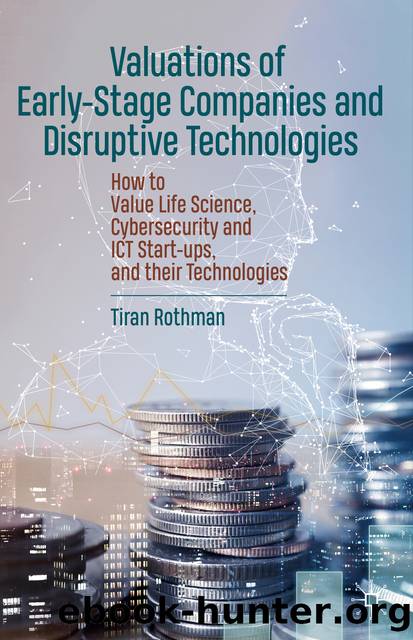Valuations of Early-Stage Companies and Disruptive Technologies by Tiran Rothman

Author:Tiran Rothman
Language: eng
Format: epub
ISBN: 9783030388478
Publisher: Springer International Publishing
8.1.4.1 How the Ride-Sharing Investment Opportunity Compares with the Life Sciences
The hype accompanying the stock market listings of ride-sharing companies led to inflated initial public offering prices that have fallen considerably for both Uber and Lyft. Historical data shows a similar tendency in life sciences companies. Both industries are heavily regulated for efficacy and safety in the case of pharmaceuticals, and for safety and low accident rates in the case of ride-sharing companies. In both cases, regulation is stringent because of the life and death consequences involved. This regulatory environment influences investor behavior concerning the risk profile of both industries. There is also a striking similarity in milestone analysis. During the FDA approval procedure, life science companies face milestones around their clinical trial phases of. Decisions of the FDA regarding approvals at each of the clinical milestones can strongly influence the choices of investors in life science companies.
The SAE, the global leader in technical learning for the mobility industry, has set five levels of vehicle autonomy: driver support, incomplete automation, provisional automation, high automation, and complete automation. Automobile manufacturers work hard to meet these five levels. However, it does not appear that milestone-based trade occurs in high volume in the ride-sharing space. For example, Lyft stock was not affected by an important announcement made in 2019 by Waymo that was rolling out level-4 autonomous robo-taxis on the Lyft app. Had such an event occurred in the pharmaceutical industry, the share price would have skyrocketed.
With pharmaceutical companies, the success rates of getting final approval from the FDA are both low and unpredictable, due not only to the actual scientific studies, but also to external factors such as competition, funding constraints, and regulatory shocks. Pharmaceutical companies are also vulnerable to FDA post-approval conditions, such as the reimbursement policies of insurance corporations. With autonomous vehicle milestones even less clear-cut than those of pharmaceutical companies, the relationship of ride-sharing companies with the market is even more uncertain.
An important caveat should be born in mind. The ultimate outcome of the FDA process, and its equivalents in other jurisdictions, is the granting of an economic monopoly in the initial years after regulatory approval to successful pharmaceutical and biotech companies. While this monopoly usually ends upon expiration of the original patent, it can be extended under certain circumstances, such as that of orphan drugs treating rare conditions. In contrast, in the cast of ride-sharing and mobility, there is a highly objective race between a few to the finish line. With nearly every main automotive manufacturer in the running, the autonomous automobile market looks set to be as oligopolistic as it is today with human-driven cars. Another important caveat is that no ride-sharing company has been listed for more than a single economic year. They are still in their very early days, and increases in demand for ride-sharing stocks following effective milestone-based progress in autonomous vehicle testing might be soon reflected in the markets.
Download
This site does not store any files on its server. We only index and link to content provided by other sites. Please contact the content providers to delete copyright contents if any and email us, we'll remove relevant links or contents immediately.
Storytelling for dummies by Andrea Fontana(1492)
Effortless by Greg McKeown(1433)
The Practice by Seth Godin(1403)
Mastering Blockchain by Lorne Lantz(1392)
Blockchain Quick Reference by Paul Valencourt & Samanyu Chopra & Brenn Hill(1149)
Mastering Blockchain by Lorne Lantz & Daniel Cawrey(909)
The wind in the willows by Kenneth Grahame(848)
How to Lead by David M. Rubenstein(823)
The Ape in the Corner Office by Richard Conniff(790)
Social Media Engagement For Dummies by Aliza Sherman(710)
Handbook of Big Data Analytics by Unknown(710)
Taking Care of Yourself (HBR Working Parents Series) by Harvard Business Review(697)
Getting Started with Data: The first book you should read to successfully get along with data. by Menegatti Gabriel & Team Simbiose Ventures(693)
FunRetrospectives: activities and ideas for making agile retrospectives more engaging by Paulo Caroli & Tainã Caetano Coimbra(691)
Business Storytelling For Dummies by Unknown(670)
Evernote for Self Publishing: How to Write Your Book in Evernote from Start to Finish by Jose John(667)
Help! My Facebook Ads Suck-- by M. D. Cooper & Jill Cooper(652)
A Leader Listens by Ajay Banga(639)
Genius by Choice: Your unconventional A–Z handbook to enhance your learning process by Remondino Giulia S(638)
